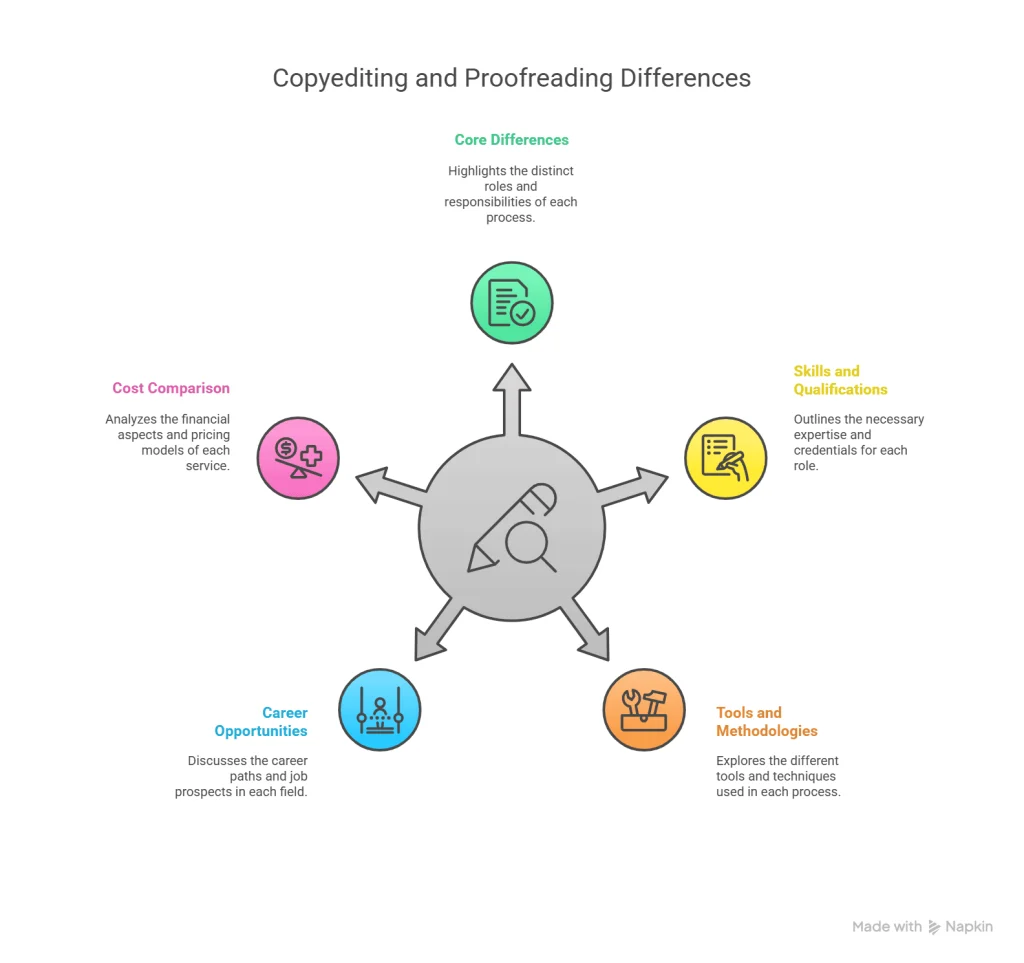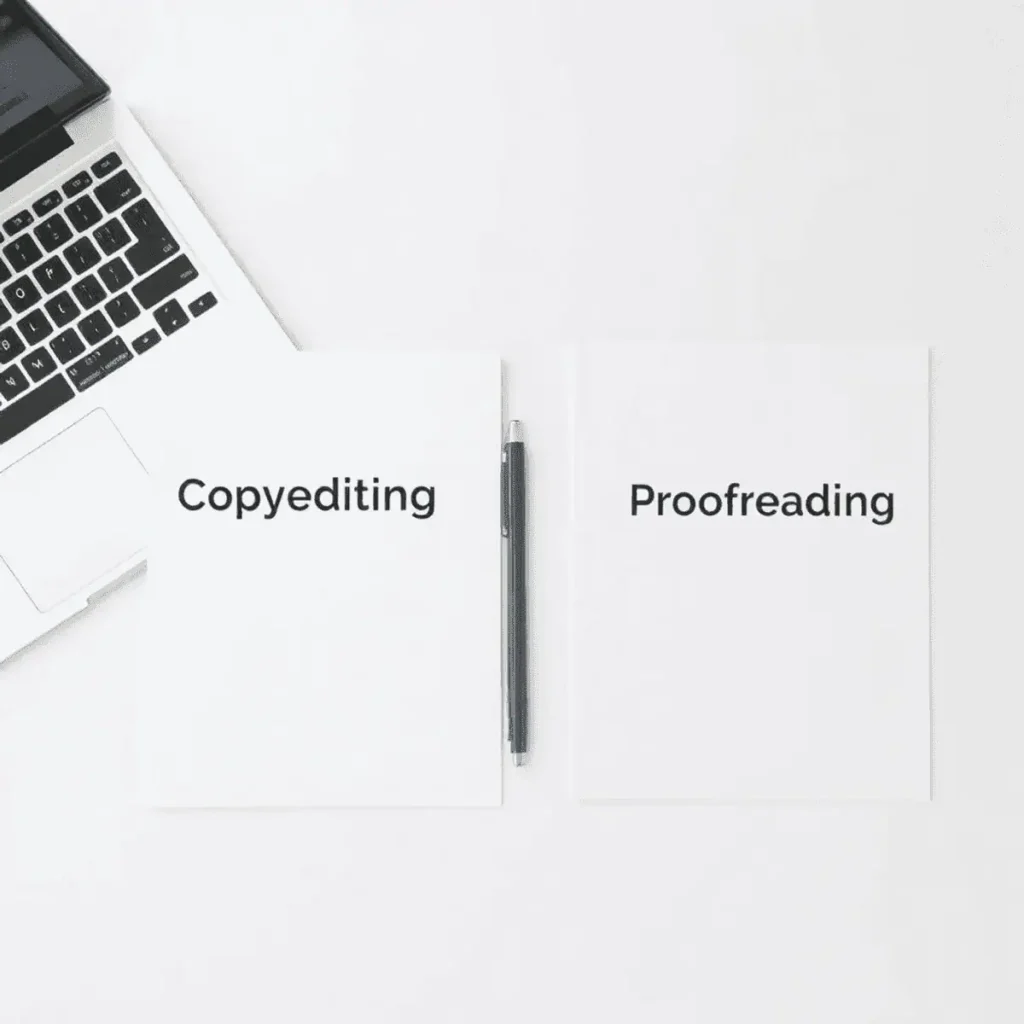As a writer or editor, knowing the difference between copyediting vs proofreading is key. Both are important in editing, but they have different roles.
For those wanting to improve their writing or editing, sites like Write Remotely are great resources. They offer insights and job chances. In this article, we’ll explore the differences between these two editing services. We’ll also talk about when to use each.
Key Takeaways
- Understanding the distinct roles of copyediting and proofreading in the editing process.
- Identifying when to apply each editing service for optimal results.
- Recognizing the importance of both services in producing polished content.
- Learning how to choose between copyediting and proofreading based on your content needs.
- Enhancing your writing or editing skills with the right resources.
What Are Copyediting and Proofreading?
Copyediting and proofreading are often mixed up, but they have different roles in editing. Knowing their differences is key to making top-notch content.
Definition of Copyediting
Copyediting is a detailed editing process. It checks content for clarity, flow, and consistency. It also looks for grammar, punctuation, and spelling mistakes. A copyeditor makes sure the content is engaging and error-free, ready for publication.
For example, a copyeditor might change sentences for better clarity. They also suggest improvements to the story’s flow.
Definition of Proofreading
Proofreading is the last step in editing. It focuses on finding and fixing surface errors like typos and punctuation mistakes. It’s a detailed check to make sure the text is perfect.
Proofreaders work with the final version of the content. They make sure all errors are fixed and the text is ready to go out.
The Editing Spectrum
The editing process spans from developmental editing to copyediting and proofreading. Each step has its own role. Understanding these roles shows the importance of professional editing services.
For more on copyediting, check out Write Remotely’s blogs. We have guides and tips to help.

The Core Differences Between Copyediting vs Proofreading
Copyediting and proofreading are not just different terms. They represent two distinct ways to refine text. As someone who has worked in content creation, I know how important it is to understand these differences. It’s key for creating top-notch publications.
Scope of Work
Copyediting is a deep dive into the content. It aims to make it clearer, more coherent, and smooth. This includes checking grammar, punctuation, and spelling. It also involves suggesting better sentence structures and word choices.
Proofreading, on the other hand, focuses on catching and fixing small errors. This includes typos, misspellings, and wrong punctuation. Knowing when to use copyediting vs proofreading is essential.
Timing in the Publication Process
Copyediting happens early in the process, after writing but before finalizing. It’s a critical step to ensure the content is engaging and error-free. Proofreading comes last, as a final check for any remaining mistakes.
For those interested in this field, checking out Write Remotely can help find the latest job openings.
Level of Intervention
Copyediting requires making deeper changes to the content. This can include altering the structure, tone, or overall message. Proofreading, by contrast, is a surface-level review. Its main goal is to ensure the text is error-free and polished.
Industry experts say copyediting aims to enhance the content, while proofreading focuses on perfecting it. For more on copyediting, blogs on Write Remotely offer valuable insights.
Skills and Qualifications Required
Knowing what skills and qualifications are needed for copy editors and proofreaders is key. Both are vital in the publishing world but need different skills.
Copy Editor Skills and Background
Copyeditors need a strong background in language and grammar. They usually have a degree in English or a related field. They must have excellent writing and editing skills to make content clearer and more coherent. Important skills include:
- Grammar and punctuation expertise
- Ability to enhance content flow and structure
- Familiarity with style guides (e.g., Chicago Manual of Style, AP Stylebook)
If you’re looking to become a copyeditor, Write Remotely can help you find the latest job openings.
Proofreader Skills and Background
Proofreaders must have a sharp eye for detail and a good grasp of grammar and spelling. While a degree in English is helpful, it’s not always necessary. Key skills for proofreaders are:
| Skill | Description |
| Attention to detail | Ability to spot small errors in text |
| Grammar and spelling knowledge | Understanding of grammatical rules and spelling conventions |
| Familiarity with style guides | Knowledge of specific style guides relevant to the industry |
Tools and Methodologies
Knowing the tools and methods for copyediting and proofreading is key to creating top-notch content. Both fields have their own ways to refine and perfect written work.
Copyediting Marks and Techniques
Copyediting uses various techniques and marks to fix and enhance text. Common marks include those for deleting, inserting, and swapping text. For example, a caret (^) is used to show where new text should go. It’s vital for the copy editor and writer to understand these marks well.
Some main copyediting techniques are:
- Changing sentence structure for better clarity
- Making sure style and formatting are consistent
- Enhancing the text’s tone and voice
Proofreading Marks and Techniques
Proofreading, by contrast, is about the last check for text errors. Proofreaders use specific marks for corrections, like a delete mark for removing extra text or a transpose mark for swapping characters or words. Their aim is to make the text flawless and ready for publication.
| Task | Copyediting | Proofreading |
| Primary Focus | Improving content clarity and style | Correcting final errors |
| Techniques Used | Revising sentence structure, ensuring style consistency | Checking for typos, grammatical errors |
| Marks Used | Insertion, deletion, substitution marks | Delete, transpose, and other correction marks |
If you’re looking to start a career in copyediting or proofreading, sites like Write Remotely are great resources. They offer job listings and insights into the field.
When to Choose Copyediting
Copyediting is the best way to make your writing clear and easy to understand. It involves a detailed check of your document to enhance its flow and readability. This ensures your message reaches your audience effectively.
Scenarios Where Copyediting is Essential
Copyediting is key in many situations, like when you’re getting a document ready for a big audience. For example, it’s vital for books, academic papers, and business reports. It helps make your writing engaging and error-free.
- Publishing a book or academic paper
- Creating marketing materials
- Developing business reports
Types of Documents That Benefit from Copyediting
Many documents can be greatly improved with copyediting. This includes manuscripts, research papers, website content, and brochures. Any document meant for public or professional use can benefit from it. For top-notch services, check out Write Remotely.
Choosing copyediting boosts your document’s quality and impact. It makes your message more powerful and clear.
When to Choose Proofreading
Knowing when to choose proofreading is key to ensuring your document’s quality. It’s the last step before publishing, aimed at fixing small errors like typos and spelling mistakes. This step is vital to make sure your document is perfect and polished.
Scenarios Where Proofreading is Sufficient
Proofreading is enough for documents that have been edited or are simple. For example, if you’re writing a short article or a basic report, proofreading is likely all you need. Also, for urgent or informal documents, proofreading can help meet deadlines or keep the right tone.
- Documents with a straightforward content structure.
- Time-sensitive publications where speed is critical.
- Internal communications or less formal publications.
Types of Documents That Need Proofreading
Many types of documents benefit from proofreading, like academic papers, business reports, and website content. Students often need proofreading for their theses or dissertations to avoid errors. Businesses also require it for reports and marketing materials.
Key documents that typically require proofreading include:
- Academic writings, such as essays and theses.
- Professional documents like reports and proposals.
- Digital content, including blog posts and articles.
Career Opportunities and Cost Comparison
If you’re thinking about a career in editing, it’s key to know the difference between copyediting and proofreading. Both are vital in the publishing world but require different skills and offer unique paths.
Copyediting vs Proofreading Jobs
Copyediting and proofreading jobs have different needs and tasks. Copyediting checks content for clarity and flow, needing a deep understanding of the material. Proofreading, by contrast, focuses on fixing grammar, punctuation, and spelling errors.
Write Remotely shows there are many jobs for both copy editors and proofreaders. The experience needed varies.
Here’s a quick look at what each job entails:
| Job Title | Primary Responsibilities | Experience Level |
| Copyeditor | Review content for clarity, coherence, and flow; suggest improvements | Intermediate to Advanced |
| Proofreader | Correct grammatical errors, punctuation, and spelling mistakes | Basic to Intermediate |
Typical Pricing Models
Pricing for copyediting and proofreading varies. It depends on the work’s complexity, the editor’s experience, and the content type. Copyediting usually costs more, with rates from $0.02 to $0.05 per word. Proofreading rates are lower, from $0.01 to $0.03 per word.
Factors Affecting Cost
Several things can change the cost of editing services. These include the content’s complexity, the editor’s experience, the project’s urgency, and the content format. For example, editing technical documents might be pricier than general articles.
For the latest editing job listings, check out Write Remotely. It’s a great place to find remote editing jobs and learn more about the field.
Conclusion
Understanding the difference between copyediting and proofreading is key. It helps you pick the right editing service for your needs. Copyediting and proofreading are two unique steps in the publishing process.
Copyediting makes your content better by improving its structure and style. Proofreading, on the other hand, checks for grammar, punctuation, and spelling mistakes. Choosing the right service ensures your document looks great and is error-free.
If you’re interested in editing, check out Write Remotely. They offer the latest job listings and helpful blogs on copyediting and proofreading.
FAQ
Is copy-editing and proofreading the same?
No, they are not the same. Copy-editing checks content for clarity and flow. Proofreading looks for grammar, punctuation, and spelling mistakes.
What is the difference between copyediting and proofreading jobs?
Copyediting is deeper, needing a strong grasp of content. It aims to improve clarity and flow. Proofreading is about finding and fixing errors. Each role has its own set of skills and qualifications.
How do I know whether I need copyediting or proofreading services?
Need copyediting for better content quality? If you’ve edited and want a final check, proofreading is enough.
What is the typical cost of copyediting vs proofreading?
Costs vary by content complexity and editing level. Copyediting is usually pricier due to its deeper editing.
Are there any websites that offer free proofreading and copyediting services?
Some websites offer free services, but quality may suffer. For top-notch editing, professional services are better.
What skills are required for copyediting and proofreading?
Both need strong language skills and detail focus. Copyeditors improve content clarity. Proofreaders are precise in error correction.


 Owner of Write Remotely. Connecting businesses with talented writers and empowering remote work.
Owner of Write Remotely. Connecting businesses with talented writers and empowering remote work. 

